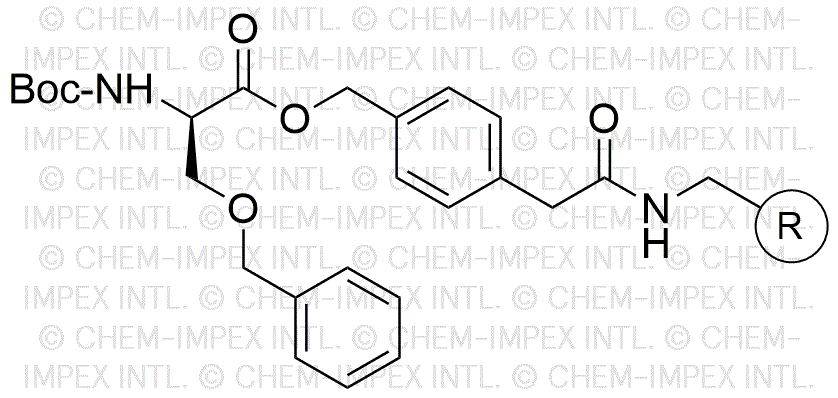Boc-O-benzyl-D-serine 4-oxymethylphenylacetamidomethyl is widely utilized in research focused on:
- Peptide Synthesis: This compound serves as a valuable building block in the synthesis of peptides, enabling researchers to create complex structures for drug development.
- Drug Design: Its unique functional groups allow for modifications that can enhance the bioactivity of pharmaceutical compounds, making it essential in medicinal chemistry.
- Bioconjugation: The compound can be used to attach biomolecules to surfaces or other molecules, which is crucial in developing targeted therapies and diagnostics.
- Research in Neuroscience: It plays a role in studying neurotransmitter systems, helping researchers understand neurological diseases and potential treatments.
- Material Science: The compound can be incorporated into polymers to create materials with specific properties, useful in various industrial applications.
General Information
Properties
Safety and Regulations
Applications
Boc-O-benzyl-D-serine 4-oxymethylphenylacetamidomethyl is widely utilized in research focused on:
- Peptide Synthesis: This compound serves as a valuable building block in the synthesis of peptides, enabling researchers to create complex structures for drug development.
- Drug Design: Its unique functional groups allow for modifications that can enhance the bioactivity of pharmaceutical compounds, making it essential in medicinal chemistry.
- Bioconjugation: The compound can be used to attach biomolecules to surfaces or other molecules, which is crucial in developing targeted therapies and diagnostics.
- Research in Neuroscience: It plays a role in studying neurotransmitter systems, helping researchers understand neurological diseases and potential treatments.
- Material Science: The compound can be incorporated into polymers to create materials with specific properties, useful in various industrial applications.
Documents
Safety Data Sheets (SDS)
The SDS provides comprehensive safety information on handling, storage, and disposal of the product.
Product Specification (PS)
The PS provides a comprehensive breakdown of the product’s properties, including chemical composition, physical state, purity, and storage requirements. It also details acceptable quality ranges and the product's intended applications.
Certificates of Analysis (COA)
Search for Certificates of Analysis (COA) by entering the products Lot Number. Lot and Batch Numbers can be found on a product’s label following the words ‘Lot’ or ‘Batch’.
*Catalog Number
*Lot Number
Certificates Of Origin (COO)
This COO confirms the country where the product was manufactured, and also details the materials and components used in it and whether it is derived from natural, synthetic, or other specific sources. This certificate may be required for customs, trade, and regulatory compliance.
*Catalog Number
*Lot Number
Safety Data Sheets (SDS)
The SDS provides comprehensive safety information on handling, storage, and disposal of the product.
DownloadProduct Specification (PS)
The PS provides a comprehensive breakdown of the product’s properties, including chemical composition, physical state, purity, and storage requirements. It also details acceptable quality ranges and the product's intended applications.
DownloadCertificates of Analysis (COA)
Search for Certificates of Analysis (COA) by entering the products Lot Number. Lot and Batch Numbers can be found on a product’s label following the words ‘Lot’ or ‘Batch’.
*Catalog Number
*Lot Number
Certificates Of Origin (COO)
This COO confirms the country where the product was manufactured, and also details the materials and components used in it and whether it is derived from natural, synthetic, or other specific sources. This certificate may be required for customs, trade, and regulatory compliance.


